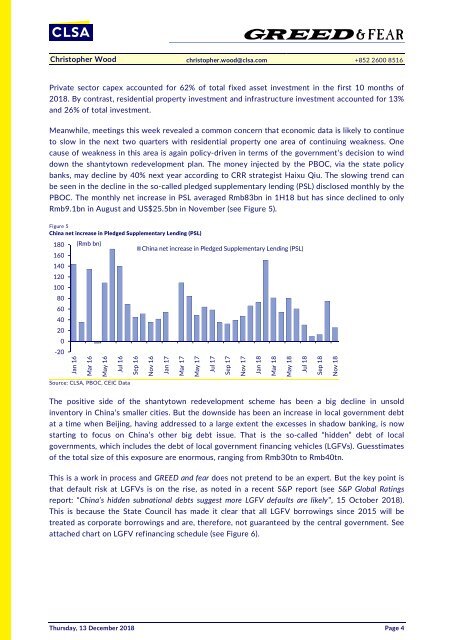You also want an ePaper? Increase the reach of your titles
YUMPU automatically turns print PDFs into web optimized ePapers that Google loves.
Christopher Wood christopher.wood@clsa.com +852 2600 8516<br />
Private sector capex accounted for 62% of total fixed asset investment in the first 10 months of<br />
2018. By contrast, residential property investment and infrastructure investment accounted for 13%<br />
and 26% of total investment.<br />
Meanwhile, meetings this week revealed a common concern that economic data is likely to continue<br />
to slow in the next two quarters with residential property one area of continuing weakness. One<br />
cause of weakness in this area is again policy-driven in terms of the government’s decision to wind<br />
down the shantytown redevelopment plan. The money injected by the PBOC, via the state policy<br />
banks, may decline by 40% next year according to CRR strategist Haixu Qiu. The slowing trend can<br />
be seen in the decline in the so-called pledged supplementary lending (PSL) disclosed monthly by the<br />
PBOC. The monthly net increase in PSL averaged Rmb83bn in 1H18 but has since declined to only<br />
Rmb9.1bn in August and US$25.5bn in November (see Figure 5).<br />
Figure 5<br />
China net increase in Pledged Supplementary Lending (PSL)<br />
180<br />
160<br />
(Rmb bn)<br />
China net increase in Pledged Supplementary Lending (PSL)<br />
140<br />
120<br />
100<br />
80<br />
60<br />
40<br />
20<br />
0<br />
-20<br />
Jan 16<br />
Mar 16<br />
May 16<br />
Jul 16<br />
Sep 16<br />
Nov 16<br />
Jan 17<br />
Mar 17<br />
May 17<br />
Jul 17<br />
Sep 17<br />
Nov 17<br />
Jan 18<br />
Mar 18<br />
May 18<br />
Jul 18<br />
Sep 18<br />
Nov 18<br />
Source: CLSA, PBOC, CEIC Data<br />
The positive side of the shantytown redevelopment scheme has been a big decline in unsold<br />
inventory in China’s smaller cities. But the downside has been an increase in local government debt<br />
at a time when Beijing, having addressed to a large extent the excesses in shadow banking, is now<br />
starting to focus on China’s other big debt issue. That is the so-called “hidden” debt of local<br />
governments, which includes the debt of local government financing vehicles (LGFVs). Guesstimates<br />
of the total size of this exposure are enormous, ranging from Rmb30tn to Rmb40tn.<br />
This is a work in process and GREED and fear does not pretend to be an expert. But the key point is<br />
that default risk at LGFVs is on the rise, as noted in a recent S&P report (see S&P Global Ratings<br />
report: “China’s hidden subnational debts suggest more LGFV defaults are likely”, 15 October 2018).<br />
This is because the State Council has made it clear that all LGFV borrowings since 2015 will be<br />
treated as corporate borrowings and are, therefore, not guaranteed by the central government. See<br />
attached chart on LGFV refinancing schedule (see Figure 6).<br />
Thursday, 13 December 2018 Page 4
















